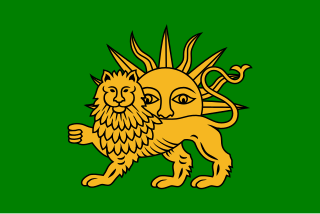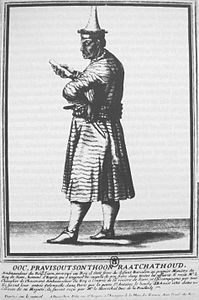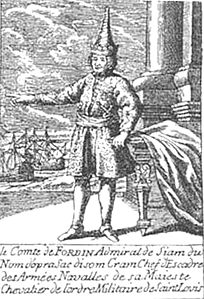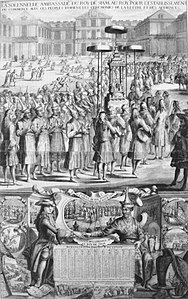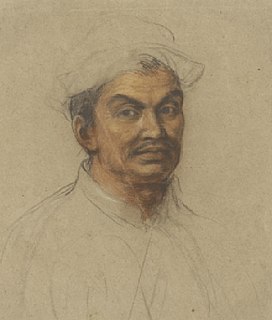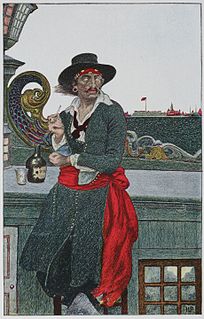
A sash is a large and usually colorful ribbon or band of material worn around the body, draping from one shoulder to the opposing hip, or else running around the waist. The sash around the waist may be worn in daily attire, but the sash from shoulder to hip is worn on ceremonial occasions only. Ceremonial sashes are also found in a V-shaped format, draping from both shoulders to the stomach like a large necklace.

King Narai the Great or Ramathibodi III was the 27th monarch of Ayutthaya Kingdom, the 4th and the last monarch of the Prasat Thong dynasty. He was the king of Ayutthaya Kingdom from 1656 to 1688 and arguably the most famous king of the Prasat Thong dynasty.

A top hat, beaver hat, high hat, silk hat, cylinder hat, chimney pot hat or stove pipe hat, sometimes also known by the nickname "topper", is a tall, flat-crowned, broad-brimmed hat, worn by men from the latter part of the 18th to the middle of the 20th century. By the end of World War II, it had become a rarity in ordinary dress, though it continued to be worn in specific instances, such as state funerals, also by those occupying prominent positions in the Bank of England, by certain City stock exchange officials and occasionally when passing between the Law Courts and Lincoln's Inn, London by judges of the Chancery Division and Queen's Counsel.

A slouch hat is a wide-brimmed felt or cloth hat most commonly worn as part of a military uniform, often, although not always, with a chinstrap. It has been worn by military personnel from many different nations including Australia, Britain, India, New Zealand, Southern Rhodesia, France, the United States, the Confederate States, Germany and many others. Australia and New Zealand have had various models of slouch hat as standard issue headwear since the late Victorian period.

Formal wear, formal attire or full dress is the traditional Western dress code category applicable for the most formal occasions, such as weddings, christenings, confirmations, funerals, Easter and Christmas traditions, in addition to certain audiences, balls, and horse racing events. Formal attire is traditionally divided into formal day and evening attire; implying morning dress before 6 p.m., and white tie afterwards. Generally permitted other alternatives, though, are the most formal versions of ceremonial dresses, full dress uniforms, religious clothing, national costumes, and most rarely frock coats. In addition, formal attire may be instructed to be worn with official orders and medals.

The tricorne or tricorn is a style of hat that was popular during the 18th century, falling out of style by 1800, though actually not called a "tricorne" until the mid-19th century. During the 18th century, hats of this general style were referred to as "cocked hats". At the peak of its popularity, the tricorne varied greatly in style and size, and was worn not only by the aristocracy, but also as common civilian dress, and as part of military and naval uniforms. Typically made from animal fiber, the more expensive being of beaver-hair felt and the less expensive of wool felt, the hat's most distinguishing characteristic was that three sides of the brim were turned up (cocked) and either pinned, laced, or buttoned in place to form a triangle around the crown. The style served two purposes: first, it allowed stylish gentlemen to show off the most current fashions of their wigs, and thus their social status; and secondly, the cocked hat, with its folded brim, was much smaller than other hats and therefore could be more easily tucked under an arm when going inside a building, where social etiquette dictated that a gentleman should remove his hat. Tricornes with laced sides could have the laces loosened and the sides dropped down to provide better protection from the weather, sun, and rain.

A bearskin is a tall fur cap, usually worn as part of a ceremonial military uniform. Traditionally, the bearskin was the headgear of grenadiers and remains in use by grenadier and guards regiments in various armies.
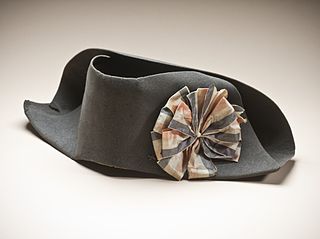
The bicorne or bicorn is a historical form of hat widely adopted in the 1790s as an item of uniform by European and American military and naval officers. It is now most readily associated with Napoléon Bonaparte but in practice most generals and staff officers of the Napoleonic period wore bicornes, and it survived as a widely worn full-dress headdress until at least 1914.

The pith helmet, also known as the safari helmet, sun helmet, topee, sola topee or topi, is a lightweight cloth-covered helmet made of sholapith. Pith helmets were often worn by European travelers and explorers, in the varying climates found in Africa, Southeast Asia, and the tropics, but have also been used in many other contexts. They were routinely issued to European military personnel serving overseas "in hot climates" from the mid-nineteenth to the mid-twentieth century.

A fascinator is a headpiece, a style of millinery. Fascinators were originally a form of lightweight knitted head-covering. Since the 1990s the term refers to a type of formal headwear worn as an alternative to the hat; it is usually a large decorative design attached to a band or clip, sometimes incorporating a base to resemble a hat, in which case it may be called a hatinator.

The rue de Siam is the main arterial street of Brest. Its name comes from the arrival of three ambassadors led by Kosa Pan, sent by the King of Siam on the 29 June 1686 to meet Louis XIV in Versailles. They went with six mandarins, three translators, two secretaries and a retinue of servants, loaded with presents. They traveled on the boats l'Oiseau and La Maligne.
Religious clothing is clothing which is worn in accordance with religious practice, tradition or significance to a faith group. It includes clerical clothing such as cassocks, and religious habit, robes, and other vestments. Accessories include hats, wedding rings, crucifixes, etc.
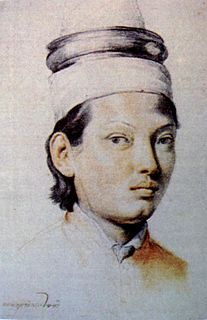
Ok-khun Chamnan Chaichong was a Siamese diplomat who visited France and Rome on an embassy in 1688. He was preceded by the embassy of Kosa Pan in 1686.

The Siamese embassy to France in 1686 was the second such mission from the Kingdom of Siam. The embassy was sent by King Narai and led by ambassador Kosa Pan. This embassy was preceded by the First Siamese Embassy to France, composed of two Siamese ambassadors and Father Bénigne Vachet, who had left Siam for France on January 5, 1684.

Diplomatic uniforms are ornate uniforms worn by diplomats—ambassadorial and consular officers—at public occasions. Introduced by European states around 1800 and patterned on court dress, they were abandoned by most countries in the twentieth century, but diplomats from some countries retain them for rare, formal occasions.
Thai traditional costumes vary by city and the ruler of each historical period. Thai clothes can be classified according to six distinct periods of history; beginning with the 11th Buddhist century. Previously, traditional Thai clothes were worn daily; however, they are now only worn on auspicious functions such as Thai traditional marriage ceremonies.

The khrui is a light outer garment worn as a gown or robe in certain ceremonial settings in Thailand. It is long-sleeved and open at the front, and is made of a sheer or mesh fabric, lined with a band of satin, felt or other material, and may be exquisitely embroidered. Dating from at least the 17th century, it was originally worn only in the royal court, but nowadays is most recognisable as the form of academic dress employed by many universities, especially Chulalongkorn University.

Traditional Thai clothing is called chut thai, which literally means "Thai outfit". It can be worn by men, women, and children. Chut thai for women usually consists of a pha nung or a chong kraben, a blouse, and a sabai. Northern and northeastern women may wear a sinh instead of a pha nung and a chong kraben with either a blouse or a suea pat. Chut thai for men includes a chong kraben or pants, a Raj pattern shirt, with optional knee-length white socks and a sabai. Chut thai for northern Thai men is composed of a sado, a white Manchu styled jacket, and sometimes a khian hua. In formal occasions, people may choose to wear a so-called formal Thai national costume.

The chada, magaik, mongkut and mokot are headdresses used as crowns in the mainland Southeast Asian monarchies of today's Thailand, Cambodia and (historically) Laos and Myanmar, and in classical court dances including khon/khol and the various forms of lakhon. They feature a tall pointed shape, are made of gold or a substitute, and are usually decorated with gemstones.



